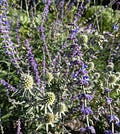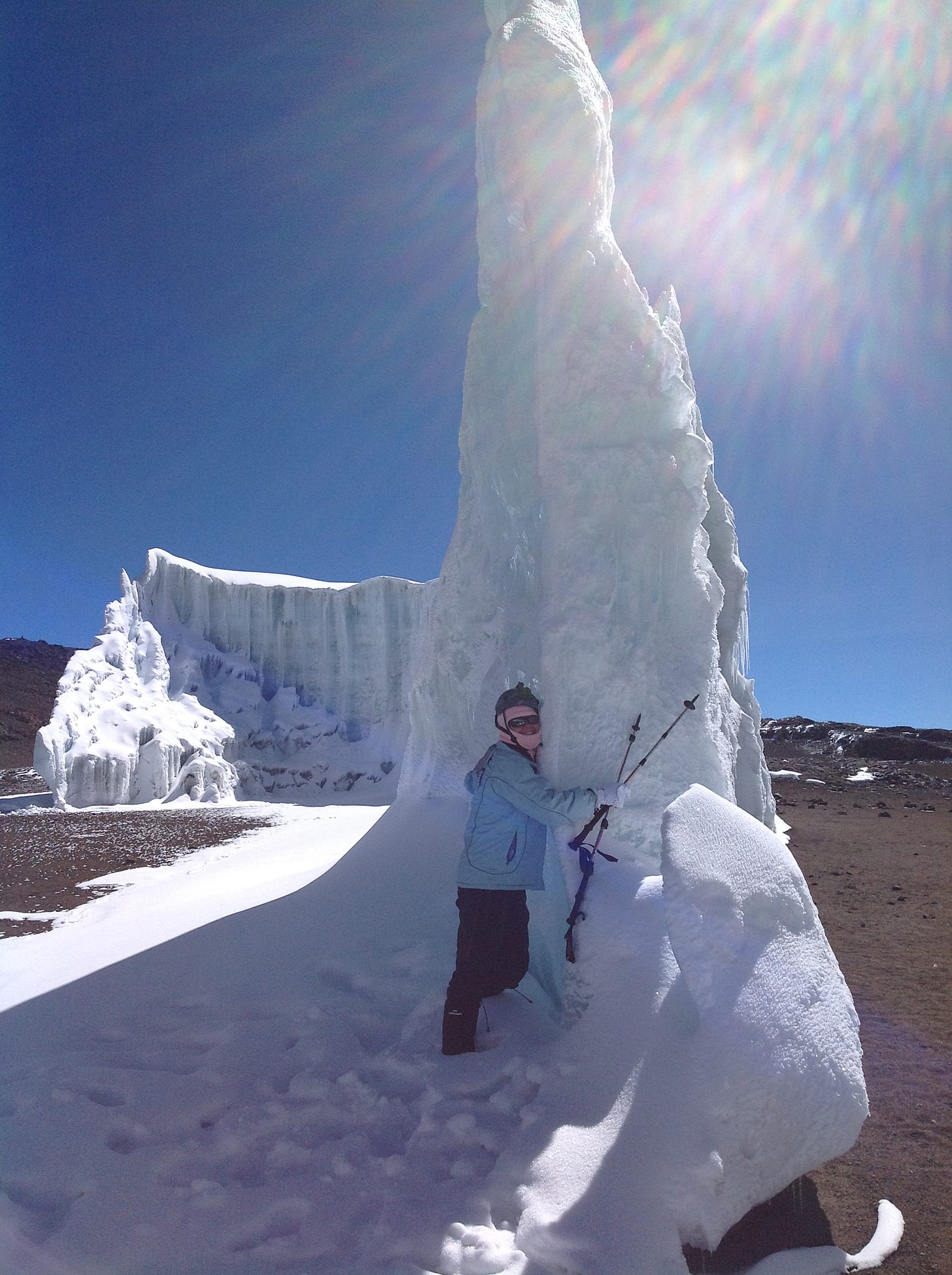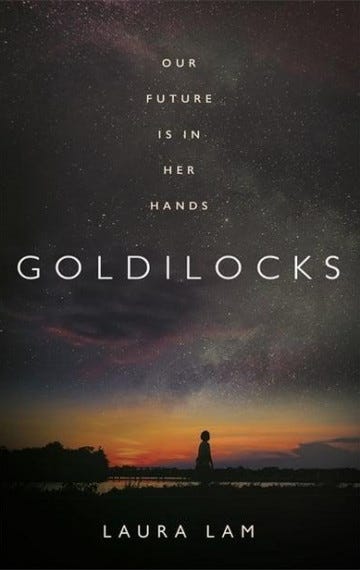August, authoring and adaptation
Thriving in the dry, cultivating change, and flowers grown in space...
In this issue…
What’s growing this month: my favourite drought-tolerant perennials
From the garden office: why so much of my writing is about arid places
Greenhouse guest: The wild gardens of childhood and what to grow on a space voyage with Sunday Times Bestselling science fiction and fantasy author L. R. Lam
I’ve been away from my garden for a month. Shock, horror. I know.
August would usually find me enjoying my favourite seat in the front yard, immersed in a sea of blue, pink and purple. There’s mauve and magenta Verbena bonariensis. Cobalt and sky Echinops ritro (globe thistle). Silver and lilac Salvia yangii. Instead of waves, this plant ocean has its own relaxing sound—bees of all stripes buzzing away in industrious rapture. I can happily watch them for hours.
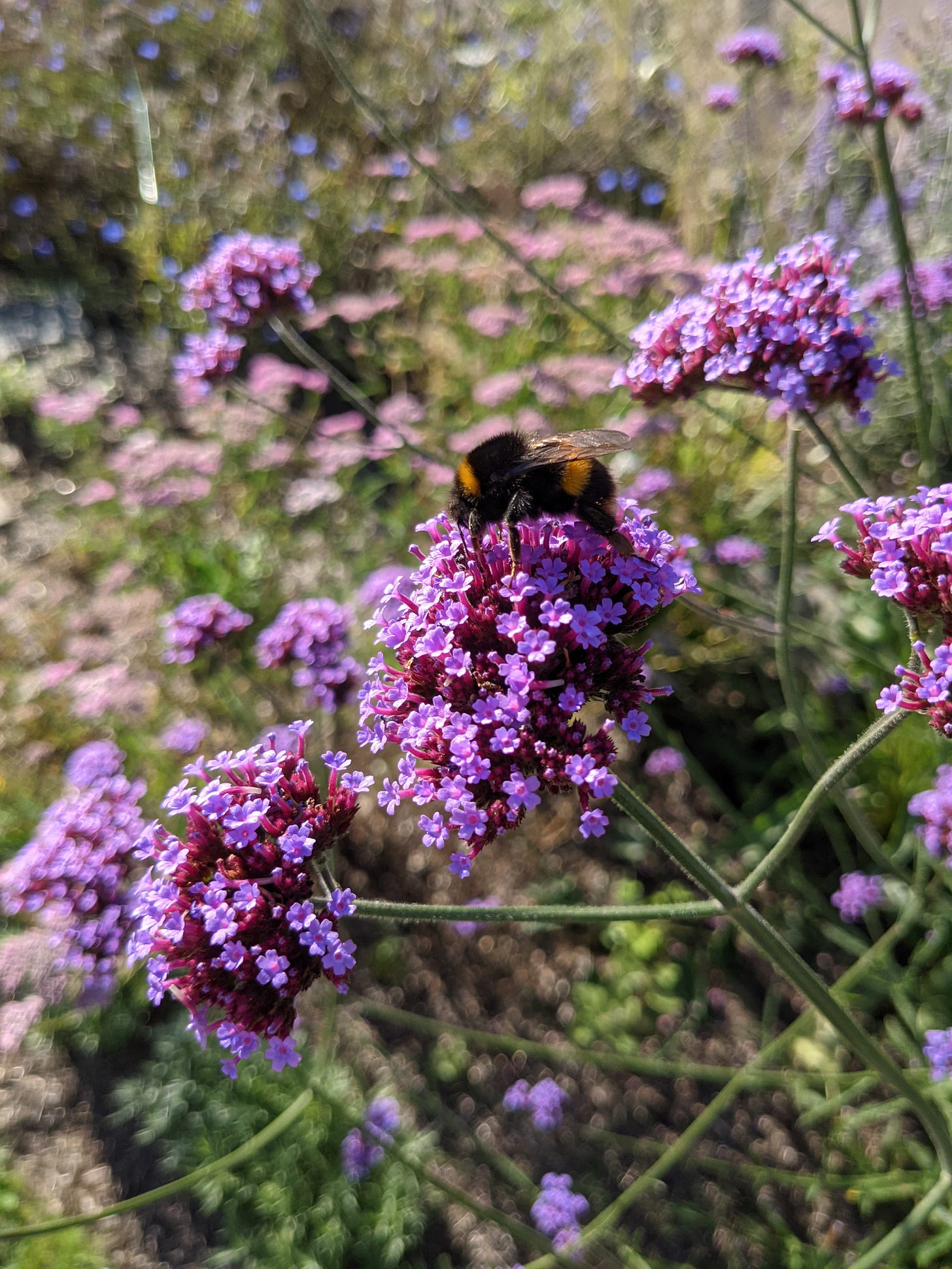
When I returned from my trip, the sea of blooms was still going strong. But in some other parts of the garden? My plant friends were decidedly worse for wear after the Summer of No Rain. Yes, even in Scotland where there’s basically a hundred words for all things damp weather–smirr, dreich and so on—there was little-to-none of the wet stuff.
Being an Aussie, when I moved to the east coast, I looked into the average annual rainfall. Many people don’t believe me when I tell them it has similar average precipitation to Sydney. Scotland has a reputation for rain, doesn’t it? Not everywhere. And as climate change marches onward—not reliably.
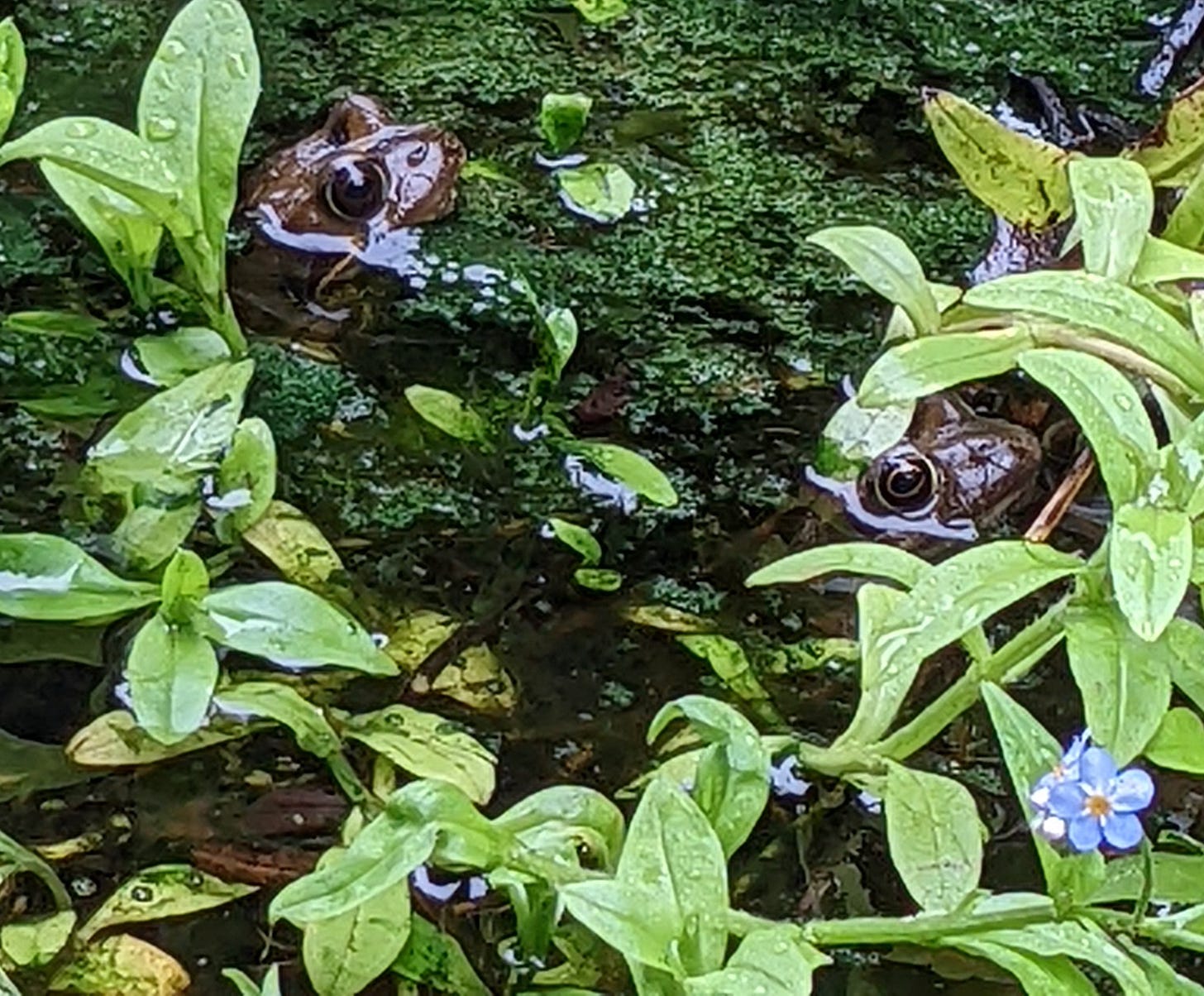
Why am I even talking about this, in a newsletter that is so often about finding comfort? Well, when you combine growing up during the longest drought in Australian history, university degrees in archaeology and sociology, and a love of fantasy and science fiction, you get… a keen fascination with how societies past, present and imagined perceive and manage water.
My childhood household relied on rainwater tanks that always seemed on the verge of empty. As a young adult, every day I passed a billboard displaying a warning in red neon of my city’s dwindling reservoir levels. Well-planned access to water during bushfire season has saved (sometimes barely) friends’ and family’s lives and homes.
Since, I’ve visited deserts in Australia and the US, ventured into Uzbekistan to camp on the remote shores of the dying Aral Sea, climbed Mount Kilimanjaro to see the only (and vanishing) glaciers in Africa, and hiked Ancient Roman aqueducts across Europe.
It’s why my favourite of all my published short stories will always be What Matters it Now if the Soil Be Soaked (in this anthology from Penguin): two high school girls from opposite sides of the tracks unite against corrupt water zoning in a near-future Melbourne. It’s also why I made several provinces in Shadowscent’s Aramtesh arid, including protagonist Rakel’s home. And now, it’s why, even as I look at some of the more parched parts of the garden, I’m already thinking about adapting.
Anyone who has been an author for longer than a blink will agree that one of the key skills for a sustainable writing career is the ability to acclimate to change. Take the way we communicate with you, dear readers. A decade ago, received wisdom was that a blog was essential. Now, many people would declare TikTok rules. My energy goes into the deeper conversations I can have via this newsletter, much like my friend Amie Kaufman talks about in the launch of Finding North earlier this week. It makes me think of a horticulture philosophy that organic gardeners adopt: right plant, right place. So here we are. Have some flowers to brighten your day. ☺️
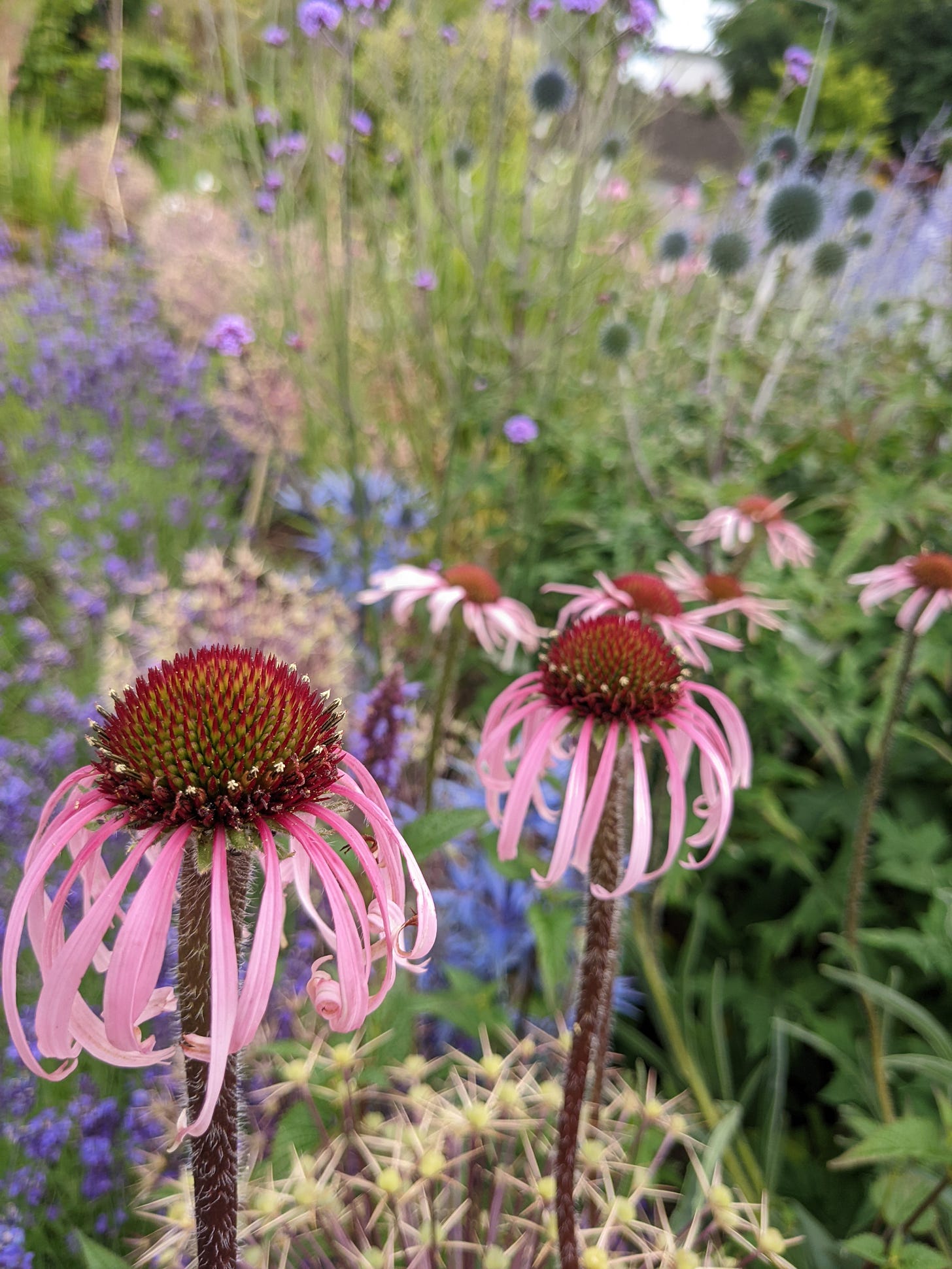
Back out in the garden, this willingness to adapt is not a tacit acceptance of climate crisis, a kind of ‘giving up’. It’s working with what’s already here. Nurturing hope, yet trying to tread lightly. In our part of Scotland we didn’t (yet) have a formal hosepipe ban, but I still asked my wonderful partner to water the few plants that otherwise would have died while I was away with a watering can, not an inefficient sprinkler. I’m glad, however, that Past Pete had the foresight (or just a convenient penchant) for perennials that like things toasty and dry. That purple and blue haze I so adore? It’s all drought tolerant. More of that, please.
I’m also not a huge fan of weeding, which makes me a huge fan of mulch. I mulch like a boss. Grass clippings, straw, recycled cardboard, shredded tree prunings, homemade compost—I relish all of it. A thick layer (and I mean thicccc—no skimping!) keeps the moisture in the soil, and the plant roots cool, so far less watering is required. Before next summer, I plan to install a dripper system under the mulch, so when I need to give the more needy plants a drink (fruit and veg mostly), there will be minimal evaporation. I hope to also have a rain tank installed to capture the runoff from the garage, and there’s already a water barrel connected to the greenhouse gutters…
Wait, did I tell you I finally got an actual greenhouse? That’s a story for another month…
Us humans can adapt our relationship with plants and drought on a larger scale, too. We rely on some pretty water-needy staples in our global food supply, not least of all in Western cultures. But there are alternatives. If you’re into reading about that kind of thing, here’s a cool article about some of the plants we could be growing on a large scale instead of their thirstier counterparts.
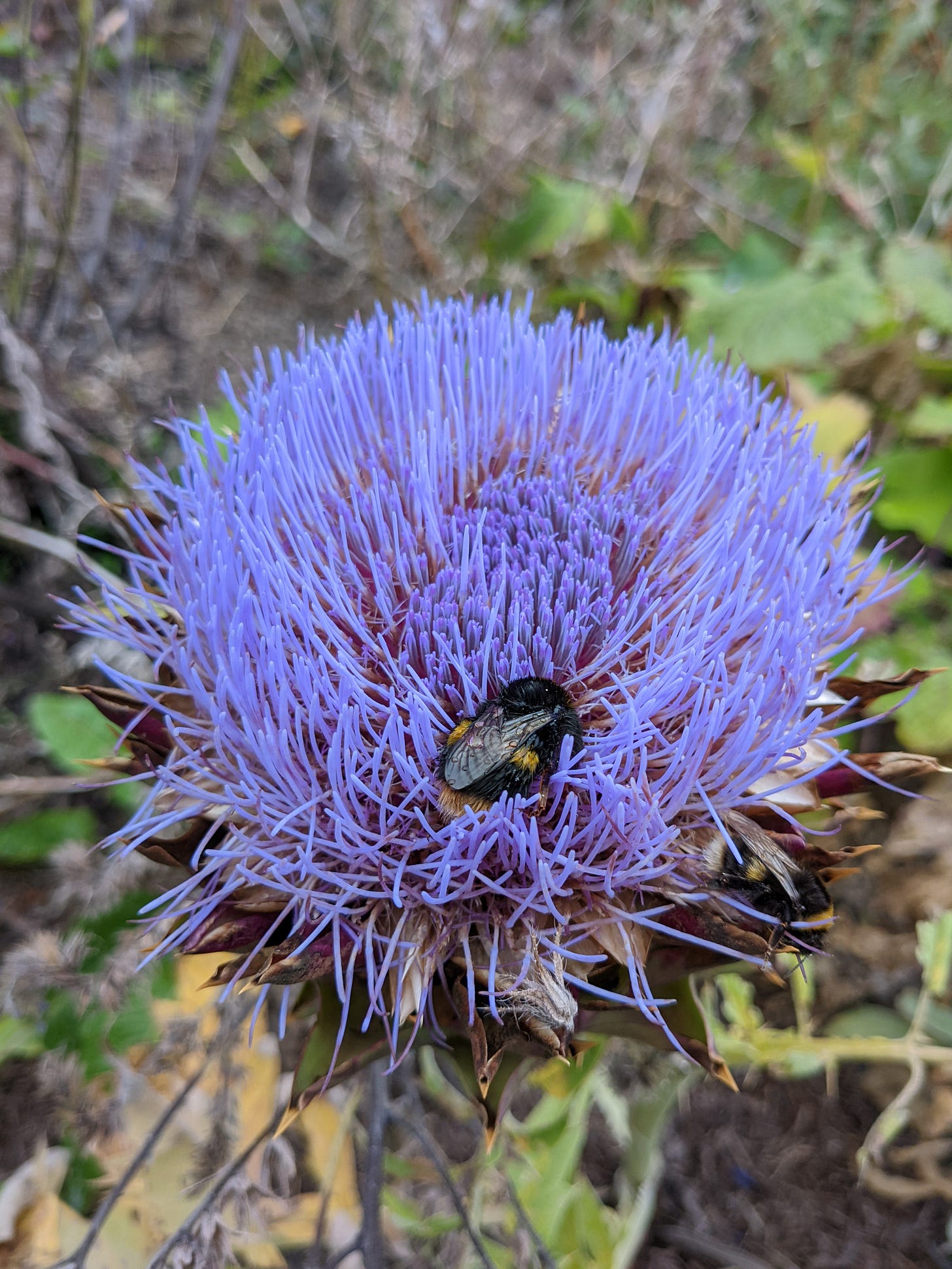
Speaking of humans adapting their botanical attitudes – this month’s guest author has a thought or three about what plants humans might value in a space-faring future…
Greenhouse Guest: L. R. Lam
Originally from sunny California, L. R. Lam (previously writing as Laura Lam) now lives in cloudy Scotland. Lam is a Sunday Times Bestselling author whose work includes upcoming epic fantasy Dragonfall, the near-future space thriller, Goldilocks, feminist space operas Seven Devils and Seven Mercies (co-written with Elizabeth May), BBC Radio 2 Book Club selection False Hearts, the companion novel Shattered Minds, and the award-winning Micah Grey series: Pantomime, Shadowplay, and Masquerade. Lam’s short fiction and essays have appeared in anthologies such as Nasty Women, Solaris Rising 3, Cranky Ladies of History, Scotland in Space, and more. Lam’s romance alter ego is Laura Ambrose. Lam lectures part-time at Edinburgh Napier University and is Programme Leader of the Creative Writing MA.
Welcome, El, please step into The Greenhouse! And may I say it’s great working with you on Edinburgh Napier’s genre-focused creative writing programmes. I pinch myself sometimes that I get to be surrounded in my day job by people who are as into fantasy, sci fi, crime, historical, romance - you name it – as I am. Shameless plug: we’re also launching a fully online version in 2023. I’m excited!
Onto the plant stuff. Opening with my usual: what’s your favourite plant and why?
I’ve always felt affinity with roses, because it’s my middle name and I was obsessed with Beauty and the Beast and assorted re-tellings as a child. They always seemed a little more magical than other flowers.
Roses do indeed capture the imagination, don’t they? It’s why I gave a paper at an academic conference last year about our love of roses in young adult science fiction and fantasy. Here’s a fun fact about roses and bestsellers: if we quantitatively analyse the YA New York Times bestseller lists over the past decade, after filtering out stop words we find ‘rose’ is the eleventh most popular root word, ahead of princesses, princes, crowns, war, witches, dreams, magic, legends and boys. Power to the rose!
It sounds like you were appreciating plants from quite a young age, is that the case?
During a difficult period of my childhood, we were extremely poor and we lived in the tiniest little one bedroom apartment in the basement of someone else’s house when I was about 4. This was in Oakland, in the Bay Area of California. But they had this absolutely massive overgrown garden. Grass taller than I was at the time, full of lemon clover, dandelions, and blackberry thorns. Crabapple trees at the back so you could climb over the fence. I’d go hunting for roly polys and make them elaborate homes in mason jars. I remember lying in the grass, disappearing from the world, and getting scratched by the thorns. I loved it. We lived right next to the Rose Garden of Oakland, which also probably fed into my positive associations with roses mentioned above. All different types, different colours. They’d bloom then disappear in winter and I’d wait for them to appear again.
Ha! I had to look up what a roly poly was – that’s a way better and more evocative name than woodlice! So, since the days of Californian gardens and bugs in jars, what role have plants played for you?
One thing I’m realising is that I do need more plants in my life. So much of my time is spent staring at screens, living in a city flat. I’m lucky that in Edinburgh there are many ways to escape—I can walk to the sea from here, or along the Waters of Leith. But it’s more just admiring plants in a passive sense, that way. I don’t know the names of many. I don’t know what to forage, when and where, like some of my more witchy friends do. During lockdown, my husband got very involved in tending to house plants, but I’ve been too afraid to get involved in case I kill them. I’m desperate to re-learn to drive so that I can properly escape into the wilds of Scotland when I need to get away from it all.
We shall go a-foragin’ some time. But for now, honing in on ideas of wild escapes – what about your creative work? How do plants feature there?
For most of my books, I use plants more for atmosphere or for thematic architecture. I’ve looked up the language of flowers and chosen specific blooms to add subtext to a scene, for example. I’ve named characters after specific plants. Redwoods, or sequoias, were quite important for my book False Hearts, since the cult where my main characters grew up was in the setting of Muir Woods, outside San Francisco. It’s lush, primordial, and tied into the “unspoiled” nature of the cult.
You know, I’m going to push you on this one. Because I can think of a specific example where plants were key to one of your stories and… I’m allowed to insist in my own greenhouse, yeah?
You’re right. In Goldilocks, my main character is a botanist, so plants feature pretty heavily. Naomi is in charge of growing food on the spaceship as she and four other women aim to journey to an exosolar planet to save a dying earth. Zinnias hold a special place in her heart as they were one of the first flowers grown in space, so she has a little pot of them in her room. Otherwise, though, it’s all things she can eat or use to make oxygen, particularly cyanobacteria like spirulina. It also tied in thematically: how do you still grow in the face of a harsh environment, like space? What does it mean to care for nature, where did we go wrong that we became so destructive to our home planet we have to go to a Planet B?
I’ve also created plants, like the purple blooms in Seven Mercies, the sequel to Seven Devils. The people believe the blooms are holy, and that each flower represents a drop of spilled blood in the long-ago war with the main evil empire, the Tholosians.
Given all that, you must have done some pretty cool plant research! Any fun finds you’d like to share?
I luckily have a friend who is a biologist who focuses particularly on cyanobacteria, Dr. Sinead Collins, so she was a particular boon for Goldilocks. I looked at how to grow plants hydroponically, and plenty of minutiae of how to grow plants in space wasn’t able to make it into the final publication.
In my most recent work-in-progress, an epic fantasy with dragons called Dragonfall, I did some plant-adjacent research by looking into how algae blooms affect plant and marine life. In another part of the world, people use giant carnivorous plants as traps for small prey, which I thought was quite interesting but also gross. I’ve also had to research what type of plants might be in the dragon world, which is slowly growing warmer due to, essentially, climate change. Mycelium networks also have thematic relevance, but I can’t say too much without spoilers!
That said, I don’t think plants have featured as much as they might have in my work because I don’t know that much about it first-hand. I haven’t really gotten my hands dirty in the soil or been patient enough to watch things grow. I’m very easily intimidated, or I know I’d berate myself if my ignorance resulted in a lot of dead plants. But If I ever do live somewhere with my own patch of earth, I’m going to try.
You don’t have to wait until then to give it a try, honest. Even if your husband is the Keeper of the House Plants, you could try an experiment or three. After all, that’s a lot of what gardening is – experimentation. One of my favourite plant writers (and experienced commercial organic grower) is Claire Ratinon. Among others, she wrote a fab book called How to Grow Your Dinner Without Leaving the House. It was so helpful when I was still doing apartment living. Oh, and in the future when you do get your own plot, you know where I am. Season-by-season, I’m learning to master seed saving – and sharing is half the fun!
In the meantime, any fave plant media you’d like to recommend?
Margaret Atwood mentions plants and flowers quite a lot in her work, I’ve noticed. Robin Hobb as well, which isn’t surprising when you learn she lives on a farm in the Pacific Northwest and grows a lot of plants herself. I also particularly liked how Mexican Gothic by Sylvia Moreno-Garcia uses fungus/spores/mushrooms to help point to themes of decay.
Well, technically fungi aren’t plants (I know, I know, I’m a pedant), but that hasn’t stopped Mexican Gothic shooting to the top of my TBR!
Thank you so much for taking the time today to chat with me in The Greenhouse, El. And don’t forget to come check out my real greenhouse soon.
As for you, dear reader – you could go grab a copy of Goldilocks while you wait for Dragonfall and the September edition of The Greenhouse. It’s going to be jam-packed, because it’s harvest month. Get it? Harvest. Jam. Packed.
Yeah, I’ll see myself out…

